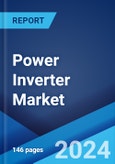Power inverters are electric devices that transform direct current (DC) into alternating current (AC). Unlike generators, power inverters offer low operating cost and eliminate the inconvenience of using change-over switches. Owing to these characteristics, they are used to operate several tools, household appliances and other electrical products. Power inverters are available in a variety of sizes, types and power ranges as per the varied consumer needs and preferences. Some of these variants include modified sine wave power inverters, plug-in grid tie power inverters, and solar power inverters.
Power Inverter Market Trends:
The rapid economic growth and rising disposable incomes of individuals across the globe have enabled them to spend more on products like power inverters, which enhance their lifestyles and provide comfort. Along with this, with rapid urbanization and growing electrification rates, most people nowadays rely on electronic appliances and gadgets. This has resulted in a significant need for an uninterrupted power supply, in turn increasing the sales of power inverters as an alternate backup solution in case of outages. Besides this, they are noise-free and environment-friendly in nature as they do not emit carbon emissions and eliminate the need for gasoline, which is required for running generators. Moreover, manufacturers are investing in research and development (R&D) activities to introduce new technologies and enhance their operational characteristics. For instance, they have recently invented a new class of power inverters, which use a single switching transistor and generate infinite levels of voltage, as compared to inverters that use multiple transistors and provide only one voltage level.Key Market Segmentation:
The publisher provides an analysis of the key trends in each sub-segment of the global power inverter market report, along with forecasts at the global and regional level from 2024-2032. The report has categorized the market based on type, application and end-use sector.Breakup by Type:
- < 5KW
- 5KW to 95KW
- 100KW to 495KW
- Above 500KW
Breakup by Application:
- Motor Drives
- Uninterruptible Power Supply (UPS)
- Rail Traction
- Wind Turbines
- Electric Vehicles/Hybrid Electric Vehicles (EVs/HEVs)
- Solar PVs
- Others
Breakup by End-Use Sector:
- Utility
- Residential
- Commercial and Industrial
Regional Insights:
- Asia Pacific
- North America
- Europe
- Middle East and Africa
- Latin America
Competitive Landscape:
The market is fragmented in nature with the presence of various large and small manufacturers present in the industry. Some of the leading players are:
- SMA Solar Technology AG
- Omron Corporation
- ABB Ltd
- Tabuchi Electric Co., Ltd
- Toshiba Mitsubishi-Electric Industrial Systems Corporation (TMEIC)
- Advanced Energy Industries, Inc
- Enphase Energy, Inc
- Schneider Electric SE
- Huawei Technologies Co., Ltd
- SolarEdge Technologies Inc
Key Questions Answered in This Report
1. What is the size of the global power inverter market?2. What is the expected growth rate of the global power inverter market?
3. What are the key factors driving the global power inverter market?
4. What has been the impact of COVID-19 on the global power inverter market?
5. What is the breakup of the global power inverter market based on the type?
6. What is the breakup of the global power inverter market based on the application?
7. What is the breakup of the global power inverter market based on the end-use sector?
8. What are the key regions in the global power inverter market?
9. Who are the key players/companies in the global power inverter market?
Table of Contents
Companies Mentioned
- SMA Solar Technology AG
- Omron Corporation
- ABB Ltd
- Tabuchi Electric Co. Ltd
- Toshiba Mitsubishi-Electric Industrial Systems Corporation (TMEIC)
- Advanced Energy Industries Inc.
- Enphase Energy Inc.
- Schneider Electric SE
- Huawei Technologies Co. Ltd.
- SolarEdge Technologies Inc.
Methodology

LOADING...
Table Information
| Report Attribute | Details |
|---|---|
| No. of Pages | 146 |
| Published | March 2024 |
| Forecast Period | 2023 - 2032 |
| Estimated Market Value ( USD | $ 80 Billion |
| Forecasted Market Value ( USD | $ 121.7 Billion |
| Compound Annual Growth Rate | 4.8% |
| Regions Covered | Global |
| No. of Companies Mentioned | 10 |









